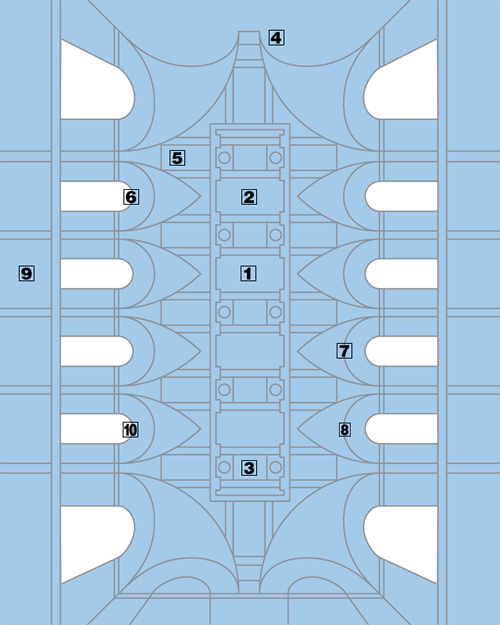Sistine Chapel Works

Plan of the Sistine Chapel
Adam and Eve
God imparts the spark of life to Adam in one of western art’s most famous scenes, then pulls Eve from Adam’s rib.
Creation
God
separates darkness from light, water from land and creates the Sun and
Moon. Michelangelo veers towards blasphemy by depicting God’s dirty
feet.
The Sacrifice, Flood, and Drunkenness of Noah
After
disassembling his scaffolding and gazing from floor level, Michelangelo
noticed that these three tumultuous scenes were too minutely drawn.
Last Judgment
This vast work identifies saints by their medieval icons: Catharine with her wheel, Bartholomew with the knife which flayed him.
Sibyls and Prophets
Hebrew prophets, including Jonah shying away from the whale, mingle with the Sibyls who foretold Christ’s coming.
Old Testament Salvation Scenes and Ancestors of Christ
Portraits
from Jesus’s family tree are above the windows, and bloody Salvation
scenes, including David and Goliath, are on corner spandrels.
Life of Christ Scenes
The chapel’s right wall stars Botticelli’s Cleansing of the Leper, Ghirlandaio’s Calling of Peter and Andrew, as well as Perugino’s work.
Giving the Keys to St Peter
Classical
buildings form the backdrop to this pivotal scene of transferring power
from Christ to the popes. Each scene is divided into three parts.
Life of Moses Scenes
Left wall highlights include Botticelli's Burning Bush and Signorelli and della Gatta’s Moses Giving his Rod to Joshua.
Botticelli’s Punishment of the Rebels
Schismatics question Aaron’s priestly prerogative to burn incense. A vengeful Moses opens the earth to swallow them.
Understanding the Sistine Chapel Art
The Sistine’s frescoes
are not merely decorations by some of the greatest Renaissance artists –
the images tell a story and make a complex theological argument. Pope
Sixtus IV commissioned wall frescoes for the Pope’s Chapel in 1481–83.
They were intended to underscore papal authority, in question at the
time, by drawing a line of power from God to the pope. In the Life of
Moses cycle, Moses’ and Aaron’s undisputed roles as God’s chosen
representatives are affirmed by the fate of those who oppose Aaron –
significantly and anachronistically wearing a papal hat – in the Punishment of the Rebels. Directly across from this work, Perugino’s Giving the Keys to St Peter
bridges the Old Testament with the New as Christ hands control of the
church to St Peter – and therefore to his successors, the popes (who are
pictured between the Sistine windows). Michelangelo’s ceiling (1508–12)
later added Genesis, Redemption and Salvation to the story.
Top 10 Painters of the Sistine ChapelSandro Botticelli (1445–1510)
Domenico Ghirlandaio (c.1449–94)
Luca Signorelli (c.1450–1523)
Piero di Cosimo (1462–1521)
Bartolomeo della Gatta (1448–1502)